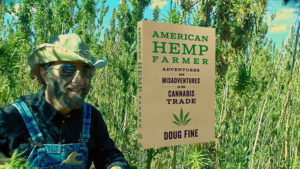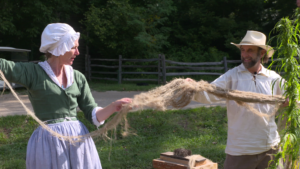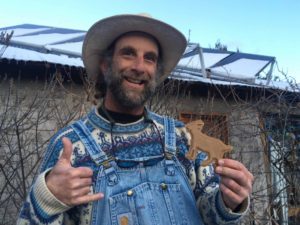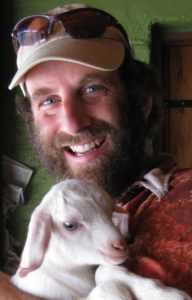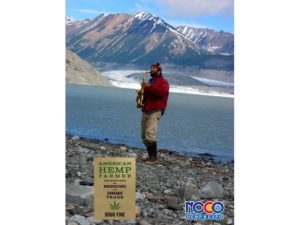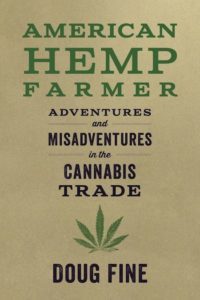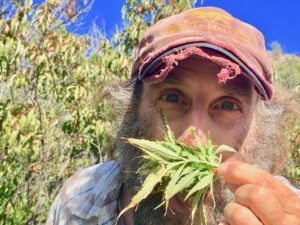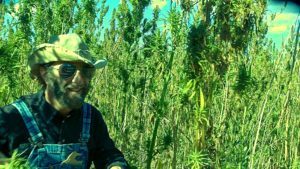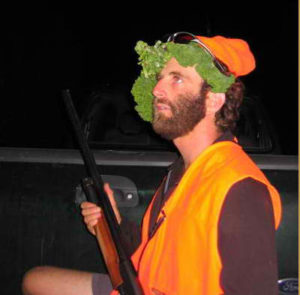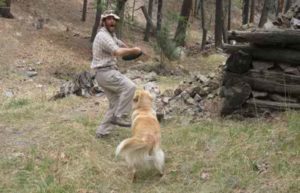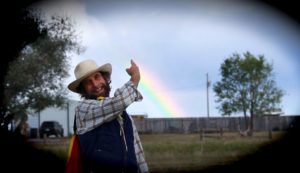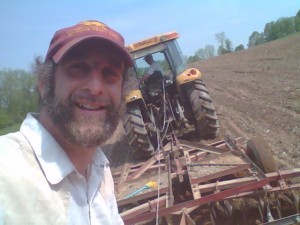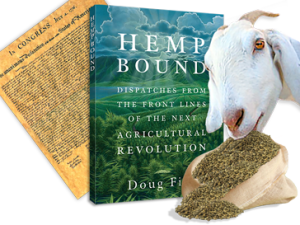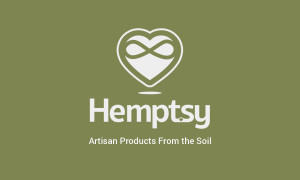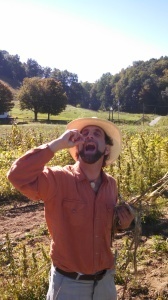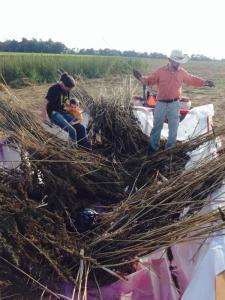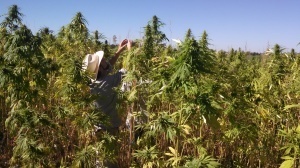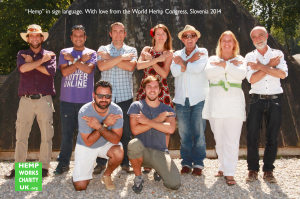Doug Fine's Blog
April 13, 2020
Superfood Security is a Seed Away: Doug Fine’s AMERICAN HEMP FARMER is here.
Doug Fine’s AMERICAN HEMP FARMER is here.
As are many of us, I’m feeling grateful for a lot of things at the moment. In particular, I’m sure glad it struck the three-years-ago-version-of-me as a fun idea to write an optimistic, humorous book that also provides a blueprint for establishing food security in your backyard.
For whatever reason, folks seem to want “funny” and “uplifting” at the moment. And laughing your way to food security? Seemed like a pleasant route. Still does. I’m doing it today – my fingers are still dank with humus as I type. Hemp farming is pretty easy, it attracts bees, and it’s all around about the most fun you can have outside the bedroom.
What I’m describing (and living) is my new book, AMERICAN HEMP FARMER. It details a season in the burgeoning and newly-legalized hemp industry from a regenerative farmer perspective. The premise is this: a billion-dollar industry is great, but only meaningful if the actual farmers benefit at the retail level from the hemp renaissance.
For customers, the win-win is that regenerative farming modes result in by-far the best hemp products. It’s not even close. Like fresh squeezed OJ beats frozen concentrate. All while sequestering carbon.
Turns out we have friends in low places. In nurturing a hemp field, we’re not the only species midwifing our hemp crop by planting time. To name one of a few hundred million, I recently gathered and brewed some fluffy white steaks of my watershed’s mycelium allies (fungus), which my family and I applying to our preseason soil in a compost tea this week.
Which leads to the core reason I wrote the book, from the introduction:
Six years ago, a bear fleeing a wildfire in our New Mexico backyard killed nearly all of my family’s goats in front of our eyes. It wasn’t the bear’s fault: he was a climate refugee. It was June of 2013, and drought had weakened the ponderosa pines and Douglas fir surrounding our remote Funky Butte Ranch. Beetles took advantage, and all of southern New Mexico was a tinderbox. Ho hum, just another climate event that until recently would have been called a “millennial” fire.
That’s the paramount reason I’m an overworked employee of the hemp plant: The people I care about most are one blaze away from joining the world’s 20 million climate refugees. At least I get the pleasure of putting “goat sitter” under occupation on my tax form.
The conflagration convinced me that I had to do something, personally, to work on this climate change problem. After some research about carbon sequestration through soil building, it became clear that planting as much hemp as possible was the best way to actively mitigate climate change and help restore normal rainfall cycles to our ecosystem.
This is why I treasure much more than just hemp’s flower gold rush (CBD, CBG, etc.). I also love hemp seed’s superfood and hemp fiber. It’s why I carry a 3D printed hemp plastic goat nearly everywhere I go.
A biomaterials-based economy doesn’t just perform better in our stuff, it means goodbye Pacific Garbage Patch. That is, when everything, even our batteries, is compostable or reusable (I mention batteries because next-generation hemp-based supercapacitors are discussed in AMERICAN HEMP FARMER).
We actually have been given a realistic opportunity to bridge humanity’s climate stabilization mission with its digital trajectory. In AMERICAN HEMP FARMER, I endeavor to connect the dots in my work, my food, and my whole life, with the thinking that if enough of us do the same, humanity’s got a shot in this here bottom of the climactic ninth.
It’s a solution-based book. Which is to say, it’s chock full of my own mistakes, as well as the triumphs and travails of many of my regenerative farmer friends and colleagues. Michael Pollan argues that we have co-evolved with certain plants, including cannabis. To be sure, hemp/human relations do go back 8,000 years. AMERICAN HEMP FARMER broaches the proud history of government-supported Hemp For Victory gardens going beyond the well-known World War II “Hemp For Victory” effort, all the way back to George Washington himself: in fact, at Mount Vernon last fall, I helped harvest the first hemp crop since President Washington’s time – I did this in colonial clothing and with (trust me) a very sharp sickle.
And that was before nutritionists knew about hemp’s ideal Omega 9-6-3 balance, high mineral content, and rare amount of GLA (gamma-linolenic acid) — a fatty acid associated with anti-inflammatory properties, Whereas my family’s own hemp diet once bankrolled the Canadian economy, for the past there years it’s been free. Hemp got federally legalized in the 2014 Farm Bill, and I and my sons get in the soil at this time every year and grow it ourselves. In AMERICAN HEMP FARMER, you’ll even read about a study that indicates a hemp diet might combat obesity.
Sowing hemp is pretty easy, and the harvest is both copious (around 1,000 pounds per acre) and extremely delicious. And I eat a lot of it. Easily a cup a day. As do both my human kids and my goat kids. Indeed it’s very hard to keep the goats out of the field. Hemp seeds are an essential part not just of my family’s health maintenance plan, but of our food security plan. And anyone can do it.
AMERICAN HEMP FARMER is available everywhere now in book, e-book and audiobook form (I narrated the audiobook, which was super fun). And I hope that you find yourself at once giggling and learning as you read it. You can order it here.
Please feel free to share this Dispatch with your friends, family and professional networks. It would be great for folks everywhere to know that not just food security, but superfood security, is a seed (and a permit) away.
Meanwhile, it’s spring on the Funky Butte Ranch, and as AMERICAN HEMP FARMER advises, I’ve got my own hemp permit application filed, I’m building soil (just as the Funky Butte apricots burst into bloom), and I’m ready to grow another scrumptious crop. I like the feeling of knowing my family will thrive for another year no matter what. When you read AMERICAN HEMP FARMER, you’ll see that you and yours can too. Thanks for reading and I hope you enjoy.
Some reviews follow below, and I’m sending immense thanks for your support/ in ordering this book and telling your friends. OK, I’m off to the field to dump more goat poop and alfalfa on the soon-to-be-planted Funky Butte Ranch hemp field
-Doug Fine
Funky Butte Ranch, New Mexico
April 13, 2020
Order AMERICAN HEMP FARMER here
Book Doug’s Live Event here.
Subscribe to the Dispatches From the Funky Butte Ranch newsletter and follow Doug on Instagram and Twitter @organiccowboy
Reviews of AMERICAN HEMP FARMER
“American Hemp Farmer would have been in George Washington’s library. President Washington grew hemp and was a passionate, regenerative agriculturist. Washington sought advice from those that practiced their trade. Doug Fine‘s American Hemp Farmer is a scholarly, practical and impeccably enjoyable work and a must-read for those who cultivate hemp or are interested in leaping in.” –J. Dean Norton, Director of Horticulture, George Washington’s Mount Vernon Estate.
“With American Hemp Farmer, Doug Fine shows he is not just our preeminent hemp author, he is one of the most important authors of our time. As I’ve watched him leap between tending goats on his Funky Butte Ranch and hemp fields in Hawaii, Oregon, Vermont and who-knows-where else, it sometimes occurs to me that he might be the most interesting man alive. The resulting book is an absolute must read. –Eric Steenstra, Executive Director, VoteHemp
“A fantastic piece of Americana that shows the way to a sustainable future.” -David Bronner, CEO, Dr. Bronner’s Soaps
“I hope every hemp farmer and policymaker reads this book carefully. It details a roadmap for success, for farmers and the planet. And that’s probably because Doug doesn’t just write about hemp, he lives it.” —Cary Giguere, State Hemp Program Coordinator, Vermont Agency of Agriculture, Food and Markets.
Further Praise for Doug’s Work
“Fine is a writer in he mold of Douglas Adams.” —Washington Post
“Fine is Bryson funny.” —Santa Cruz Sentinel
“Doug has written the best book of the year and a blueprint for the future of America.” –Willie Nelson
About Doug Fine
Doug Fine is a comedic investigative journalist, bestselling author, and a solar-powered goat herder. He has cultivated hemp for food, farm-to-table products and seed-building in four U.S. states, and teaches a college hemp class. Willie Nelson calls Doug’s work “a blueprint for the America of the future.” The Washington Post says, “Fine is a storyteller in the mold of Douglas Adams.” A website of Doug’s print, radio and television work, United Nations testimony, Conan and Tonight Show appearances and TED Talk is at dougfine.com and his social media handle is @organiccowboy.
Book Doug’s Live Event here.
Subscribe to the Dispatches From the Funky Butte Ranch newsletter and follow Doug on Instagram and Twitter @organiccowboy
January 28, 2020
The Bear Attack That Made Me A Hemp Farmer
AMERICAN HEMP FARMER is here.
A short excerpt from AMERICAN HEMP FARMER, and thoughts on the five-year journey to this follow-up to HEMP BOUND
By Doug Fine
Six years ago, a bear fleeing a wildfire in our New Mexico backyard killed nearly all of my family’s goats in front of our eyes. It wasn’t the bear’s fault: he was a climate refugee. It was June of 2013, and drought had weakened the ponderosa pines and Douglas fir surrounding our remote Funky Butte Ranch. Beetles took advantage, and all of southern New Mexico was a tinderbox. Ho hum, just another climate event that until recently would have been called a “millennial” fire.
That’s the paramount reason I’m an overworked employee of the hemp plant: The people I care about most are one blaze away from joining the world’s 20 million climate refugees. At least I get the pleasure of putting “goat sitter” under occupation on my tax form.
The conflagration convinced me that I had to do something, personally, to work on this climate change problem. After some research about carbon sequestration through soil building, it became clear that planting as much hemp as possible was the best way to actively mitigate climate change and help restore normal rainfall cycles to our ecosystem.
At least the fire’s timing was good. Hemp was de facto legalized for “research purposes” in 2014, two months before the publication of my earlier book of my about hemp, HEMP BOUND. I’ve spent the five ensuing years not just covering the new industry but joining it: developing genetics in Oregon and a farm-to-table product in Vermont; consulting, filming, and speaking all over the world; working on university research in Hawaii; and teaching a college course near the Canadian border in Vermont. Most of all I met, farmed and processed with dozens of fellow hemp farmers, all over the world. We all consider ourselves part of a functioning regenerative industry niche, with a mission statement best described as “This Time the Farmers Are In Charge.”
* * * * *
That’s from the introduction to AMERICAN HEMP FARMER. I wrote it in large part because, as anyone who has leapt in can attest, planting hemp and making a living at it can be two different endeavors. AMERICAN HEMP FARMER endeavors to blueprint possibilities for independent farmers like myself who’d like to do both, particularly on their own land. If a lot of things go right, an independent farmer (or a farmer cooperative) can make a viable living on a small number of acres. That ain’t exactly the way agriculture has been going for the past century. Just how many acres depends most of all on the part or parts of the cannabis plant you are cultivating (seed, flower, fiber, root). Another variable is whether you’re planning to create a value-added product. A third is if you’re going at it alone or in partnership with others. Regardless, the good news is being in a hemp field is the most fun you can have outside the bedroom.
If you’re like me, you learn to relish every moment on the farm, because often at this early phase we have to shape regulatory policy, which means spending time off the farm. In fact, as any hemp permit holder in any state can tell you, we’re in a bit of a code red situation at this moment – right as AMERICAN HEMP FARMER comes out, those of us who want to see the regenerative hemp industry thrive are rallying to immediately raise the federal THC definition of hemp to 1 percent.
There are a lot of reasons for this, but the immediate catalyst is that the USDA interim final hemp regulations that came out in December criminalize THC above .5 percent. That, of course, is insane. Plus, far too many farmers are testing “hot” over micro-amounts of THC under today’s antiquated .3 percent definition of hemp. The last folks who should be burdened about THC are farmers. The war on cannabis is over. Cannabis won.
Still, sometimes I think we’re wise to give thanks for bad bureaucratic decisions: everyone’s justifiably fired up, and we’re going to win this one, just like we’re going to win all battles that need to be fought to support the regenerative hemp farmers who are sequestering carbon while re-building rural communities. So we gotta tweak federal law again. No biggie. Please join us. Call your congressperson and senators today on this. Let’s get this one done this year so we can really build our genetics with confidence. Regenerative farmers are going to save humanity.
There’s much more policy to discuss (and it’s in the book), but the field is where the endorphins flow. It’s a sunny day here in the Land of Enchantment, so I’m heading out to lay some goat poop-laden organic alfalfa on my future 2020 field. Yikes, less than four months until planting. And I’ve got a dang book tour, which I’d love you to check out. More dates being added all the time here.
In closing, it’s so appropriate that AMERICAN HEMP FARMER is celebrating its release at the seventh NoCo Hemp Expo (NoCo7). For one thing it’s the biggest and best hemp event in the world — a must-attend immersion if you’re considering leaping in to hemp, a plant that has launched the biggest economic development since Silicon Valley. Also, at NoCo1 in 2014, which had 19,500 fewer attendees than NoCo7 will, I performed my first live event following the publication of HEMP BOUND. Morris, Lizzy, Lori and the whole NoCo family have been supporting my work (and regenerative hemp) nonstop ever since. My NoCo7 keynote and book signing times will be announced soon. To stay in the loop for the latest, you can join my Dispatches From the Funky Butte Ranch mailing list.
Oh, and if you do make your pre-order via the link in this dispatch, you’re supporting independent bookstores – in this case Denver’s magnificent Tattered Cover. Use code EXPO is you want to pick up your signed copy at the NoCo Expo, and of course otherwise they’ll ship anywhere. As well, when the book hits general release on April 8, you’ll be able to get it at bookstores everywhere.
I don’t think I will ever stop sending truly profound thanks to everyone who reads AMERICAN HEMP FARMERand HEMP BOUND. I couldn’t do what I do without you.
–DJF, Funky Butte Ranch, January 20, 2020
Order Doug Fine’s AMERICAN HEMP FARMER
Book Doug’s Live Event here.
Subscribe to the Dispatches From the Funky Butte Ranch newsletter and follow Doug on Instagram and Twitter @organiccowboy
Reviews of AMERICAN HEMP FARMER
“American Hemp Farmer would have been in George Washington’s library. President Washington grew hemp and was a passionate, regenerative agriculturist. Washington sought advice from those that practiced their trade. Doug Fine‘s American Hemp Farmer is a scholarly, practical and impeccably enjoyable work and a must-read for those who cultivate hemp or are interested in leaping in.” –J. Dean Norton, Director of Horticulture, George Washington’s Mount Vernon Estate.
“As a hempcrete homeowner, American Hemp Farmer is the must-read book on hemp I’m proud to keep on my shelf. Someday we may even see NBA arenas built from hemp. But for now Doug should be prepared to lose more money at the poker table that sits on the hemp floor of my hemp paneled card room.” –Two Time NBA Hall of Fame Inductee Don Nelson.
“In his latest, Author Doug Fine details the beneficial and no longer forbidden relationship between cannabis and humanity and how together there is a path to rejuvenate the entire planet. As a state hemp program administrator, I hope every hemp farmer and policymaker reads this book carefully. It details a roadmap for success, for farmers and the planet. And that’s probably because Doug doesn’t just write about hemp, he lives it.” —Cary Giguere, State Hemp Program Coordinator, Vermont Agency of Agriculture, Food and Markets.
Further Praise for Doug’s Work
“Fine is a writer in he mold of Douglas Adams.” —Washington Post
“Fine is Bryson funny.” —Santa Cruz Sentinel
“Doug has written the best book of the year and a blueprint for the future of America.” –Willie Nelson
About Doug Fine
Doug Fine is a solar-powered goat herder, comedic investigative journalist, bestselling author, and pioneer voice in regenerative farming, including cannabis/hemp. He has cultivated hemp for food and seed-building in four US states and teaches a Sterling College hemp class in Vermont. In addition, he is an award-winning culture and climate correspondent from five continents (for NPR, the New York Times, and the Washington Post, among others). His books include American Hemp Farmer, Hemp Bound, Too High to Fail, Farewell, My Subaru (a Boston Globe Bestseller), Not Really An Alaskan Mountain Man, and First Legal Harvest, a monograph that was printed on hemp paper. Willie Nelson calls Doug’s work “a blueprint for the America of the future.” The Washington Post says, “Fine is a storyteller in the mold of Douglas Adams.” A website of Doug’s print and radio work, United Nations testimony and TED Talk is at dougfine.com and his social media handle is @organiccowboy.
The post The Bear Attack That Made Me A Hemp Farmer appeared first on Doug Fine.
May 18, 2017
True Homeowners Insurance
Just before equinox in 2011, I wrote the Dispatch From the Funky Butte Ranch that follows with tongue, I thought, pretty solidly in cheek. I mean, it was ripped from the personal headlines. I really had been denied homeowner’s insurance for like the fourth time in as many months, but mostly I was just joking around about the insane illusion of “insurance” in an vast, multi-dimensional universe.
This was a time in my life, a new father working on my third book, Too High to Fail where I was entering a new phase of my lifelong Hypocrisy Reduction Project. It’s one I’m still in, probably best described as the “No More Toxic Junk In Life” phase.
During this six year period of weekly Dispatches, ideas were forming that I see now have led to the father and human I am now, including guiding much of my work focus. I also notice as I re-read these legacy Dispatches that at this time I tended to go for the laugh line at the expense of, well anything else. Good to see. If anything, we need to laugh more now. To me, still, that’s non-fiction.
Anyway, this Dispatch spoofs the belief systems that keep so many digital age folks calm. Insurance plans. Campaign platforms. Toby Keith concerts. Those sorts of institutions. Volcano sacrifice and Eastern Island statues were earlier era analogues. Here’s the thing. A lot of people took the Dispatch seriously. Thousands.
The collection of words evidently had one genuine and underlying theme that resonated and made it the most-viewed and most-commented-upon of any Dispatch to date. I wish I could find the original replies, maybe post the top three-dozen thoughtful or practical ones. Which is to say, mine was not the only progressive neo-Rugged individualist family thinking about these issues of potential post-globalization survival strategies. Most folks (my family included) sure weren’t rooting for absolutely needing such skills. We just thought their potential necessity was worth discussion. Six years later, the topic keeps coming up in conversation on and off the Funky Butte so, just back in from the morning goat milking, I hereby re-issue it.
I had to do that manually because my agent advised me to take down my older Dispatch archive as we discuss it as a forthcoming book. It’s funny because the song in my office during that discussion had the lyrics, “Give it away, give it away, give it away now.” So I’m at least giving this one away, one of my favorites.
If you feel as though you must show your regard for independent artists by remunerating for this content, please feel free to check out my existing books, a lovely Vermont indie farmer hemp project of which I’m part, my live events, and forthcoming television show (more details on that one coming), and, most importantly of all, as we all retrain to think locally, hemp industry pioneers in your community wherever you live.
Here, then, is one option for a post-collapse respite. I already pretty much live this way. It’s fun. I mean, if modern, petroleum-based globalization keeps working forever, it’s still immensely cool and satisfying to know how to make and shoot a bow and arrow.
Gotta go, Late for homeschool. On matters of bows and arrows, my sons have Inspector Clouseau as a teacher. Thankfully we all have YouTube.
March 8, 2011
True Homeowner’s Insurance
Hands-free, thanks to my new solar-powered smart phone that penetrates the Ridiculously Oversized American Truck (R.O.A.T.’s) vegetable oil haze, I’d spent a good part of the morning on the phone with my beleaguered insurance agent, Roberta. Nearly in tears with domestic and international plan cell phones pressed to her ears, she kept bouncing in a kind of insane modern shuttle diplomacy between me (on my way to an important post-goat milking riverside Frisbee engagement), the Funky Butte Ranch’s mortgage company’s Wall Street accountants, and the Customer Enraging department of my putative new (and probably last ditch) homeowner’s “insurance” company option, presumably in Bangalore, if not Neptune.
Despite the fact that I had, as she knew all too well, my own problems if some kind of miracle compromise wasn’t reached with some actuarial computers that were clearly already predicting my demise, just because off a few Millennial fire events and associated land slides on the Funky Butte Ranch in recent months, I had a hard time feeling anything but sympathy for Roberta. Today’s international nightmare was just another chapter in my Trying To Keep A Remote, Off-Grid Property Insured As Required Nonsensically By Law Saga.
The previous three months alone had included no fewer than four policy cancellations, one insurance inspector trapped trying to cross my river, and some sort of disagreement in a thousands-of-miles-distant engineering office about how far away the ancient Funky Butte Ranch wood stove is or is not from its nonflammable adobe south wall. In one memorable exchange a few weeks earlier, Roberta had called me and said, “That inspector I told you was on her way? She can’t find the Ranch.
“Oh, that’s no problem,” I reassured her. “Tell her to follow the UPS driver Mary — she usually makes it at least to the top of the driveway, and he’s on his way.”
“It’s just that, well, she’s on the other line in, um, your riverbank, citing some kind of, hold on, let me find it…‘irremediably inaccessible’ clause and is canceling your policy effective immediately via satellite phone. It’s on page 1,463 of your policy.”
I sighed. “Again?”
(Choked up) “I’ll make some calls.”
At issue is the confounding (or obvious) reality (depending on your depth of understanding of the lobbying process) that I can’t have a mortgage without homeowner’s insurance, despite the fact I possess little that will burn and almost nothing anyone would want to steal, unless you count three productive if maddening goats.
The upshot of all this is that, when it comes to companies willing to do business with a law-abiding neo-Rugged Individualist, I’m now down to the homeowner’s insurance equivalent of the guy whispering in the alley to sell you a watch. Forget about offshore — I don’t even recognize their Internet suffix. And yet clearly they have an effective lobbyist on retainer.
All for fake insurance that I have no interest in possessing, on which I never imagine I’ll be claiming let alone collecting, and which significant chunk of change I could be using for more important things like billy goat-related PTSD therapy sessions.
This was why I greeted my visiting Portland friend Bert at the riverbank, after he asked me how it’s going, by saying, “Well, generally feeling blessed, but at this exact moment I’m working to ignore problems with something I’m obligated to own but which doesn’t exist.”
He nodded sympathetically. His very living depends on such bureaucratic hoop-jumping. He’s almost used to it. Plus he’s an economist. He knows the insurance shell game, the math behind it. It is literally inhuman.
(Last time we visited, on his turf, I had been muddy from Oregon Country Fair, and I had to reject his kind offer to wash my water bottle with “those pills that make everything sudsy” by introducing him to the sodium laurel sulfate fear fest, revealing Doc Bronner’s to him, and consoling him when I saw him calculating all the toxics in his home products by giving him my increasingly common, “Don’t worry — you’ll probably be OK — some folks are surprisingly immune to toxins” speech.)
Indeed, it was this illusory notion of “insurance” of any kind on a planet, for crying out loud, where every ocean will one day be a forest and every desert a verdant alpine valley, that once again brought this young man’s springtime fancy to thoughts of post-McGlobalization survival.
It’d been a while since I’d mused so intensely on my prospects following a hypothetical collapse. For all its problems, I’m a fan of our current society’s march toward sustainability (especially with a few regenerative and fair trade tweaks). Plus, I mean, I can’t help but summon the ol’ optimism reserves: I’ve got a healthy family. Clean water. Enough food. It’s not like I have much interest in to visualizing a scenario out of The Road.
But it was two discussions in rapid succession with my PDX Progressive Bubble friend (one of my oldest and closest), punctuated by hyperventilating calls from Roberta every few minutes, that returned me to springtime thoughts of insurance.
The first thread was what you might call the “Prius Route Out of Climate Change” Fallacy. Bert couldn’t quite get his semi-electric marvel up and into the admittedly rugged Forest Service parking lot where we met, so he had to hitch a ride with me in the R.O.A.T. As we bumped those last few hundred yards to our mission critical Disk meeting, I did what you have to do when your buddy has a new car (his second in three years), which is praise it.
Bert told me with some pride, “Yeah, if you average city and highway, I’m getting nearly 30 miles per gallon. I felt I had to get one. Ya know, to do my part.”
Now, even leaving aside contemplation of dynamics like how long one tries to make one’s stuff last and the fact that my 1985 Honda Civic got something like 51 on a bad day (I filled it up just before every Congressional election, I was unable to choke down my response before it leaped out of me: “Oh, yeah, love the hybrids. Smooth and quiet (clearing throat). Can’t help feelin’, though, that many folks that live ‘round these parts kind of believe a faster pace might be necessary in order that ourspecies doesn’t, kind of/ya know, die out.”
I saw from the way that Bert blanched and in fact nearly stumbled into the river, that my longtime compadre had a lot invested (literally) in that not happening, so I tried to console him.
“Oh, don’t worry, the Earth will be fine. It regularly survives asteroids. It can handle Exxon. It’s just the people who might not be able to breathe until it recovers.”
While Bert was processing the idea of something, if true, that he could not buy his way out of, he heard me answer my phone (I have Roberta’s ringtone set to Europe’s “The Final Countdown”) and say, “Dammit. You tell Yuri that I will not pay the premium in cash Euros. And I expect the goat exemption to be in there, as we agreed.”
“Look,” Bert said when I got off the phone and we started tossing the disk (he was so discombobulated from the way the conversation had started that he nearly decapitated a merganser with his first toss). “All this talk about extinction seems to me to be a little out there.”
After diving into the wilderness waterway to retrieve the Wham-O, I decided not to tell Bert that I had polled the professional scientist audience at my most recent live event (at the University of Denver), and a somewhat convincing 100% of those in attendance agreed with me that “it’s best to be planning, just in case.”
And that was the second thread that comprised the current bullfighter’s cape dancing glaringly in front of me and forcing me to dwell on post-apocalyptic survival. I hadn’t wanted that Denver audience of tenure-track post-docs to declare me sane. I desired to be told by climatologists and biologists that I was a “little out there.”
The problem was, even though both my “Reagan was too liberal” neighbors and my “Bob Marley was a light smoker” neighbors agreed completely with the Denver professionals, I felt my recent proposals for preparation were being met with a a kind of resigned inertia. Which is to say, as a fellow always checking in on my own fluctuating prospects for post-collapse survival here on the Funky Butte, I’ve been thus far engaged in a fruitless quest to get the friendlier of my fellow valley denizens to join me in some basic preparation.
What has been somewhat frustrating to me is that these good and intelligent folks don’t have their heads buried in the sand, as many of my urban (read: insurance-believing) friends, perhaps of mental necessity, do. They simply don’t think mobilizing and preparing for the chaos of immediate post-Box Store collapse is worth the effort.
“I just don’t want to live dominated by that level of fear,” my southern valley neighbor Mook, a semi-retired engineer (on whom I’m relying to hook up the shortwave radio equipment you’ll see is integral to my plan) told me a few months ago when I proposed what I believe to be my ultimately reasonable and levelheaded strategy. “If some armed mob comes and wants my garden and chickens and even my life, I figure they can have it.”
“Even your son?” I asked petulantly.
He agreed at least to think about it.
“All I’m saying is let’s plan at least to the level of the Boy Scouts.” I pleaded, feeling a little guilty that I had already played the “Who Will Think of the Children?” card. “Is that too much to ask? Be Prepared.”
“There’s no preparing,” my northern neighbor Blake insisted lazily during a recent soak in some local hot springs, his wife massaging his neck like a scene from the Fantasy Island title sequence. “You prepare for one thing, and another unfolds.”
That was where I disagreed. For evidence, I cited both the original Minuteman and the Vietcong. “Those guys were able to assemble in no time flat, and when the worst happened, they were ready. Were they paranoid? Were they fear based?”
To this point, as I say, I’ve met with a misty veneer of skepticism locally, though that might be the flame retardant the forest service folks are dropping on the latest wildfire. More probably, folks aren’t psyched to rally for post-box store survival drilling because the local hot springs are so dang idyllic and relaxing. Not the most conducive ecosystem to inspire even moderate doses of healthy paranoia. My allies in the valley are all about food independence, but when it comes to basic defense drilling, they act like I should move to Idaho and join the some kind of militia.
Sigh. Well, I might as well lay out the specifics of my simple plan here, to see how it comes across to readers of these Dispatches:
–A dozen or so kindhearted, like-minded families in my valley each get a solar-powered shortwave radio, which runs constantly in each house on an agreed upon bandwidth within easy earshot.
–The members of each household pursue working knowledge of key survival elements, including fire starting, water purification, orienteering, archery and firearms operation and maintenance.
–Each family builds an escape tunnel (or other route as appropriate to surroundings) from its home to an area that includes a non-perishable food and water cache.
–Twice a year all dozen families drill so that, in the (heaven forbid) event of a societal breakdown or other emergency, we can rally to a radio summons within minutes, while the affected family holds off any intruders in the interim.
Those who know me will agree, I think, that I’m as Live and Let Live as the next guy, but I didn’t sleep well for weeks after reading The Road. And that audience response in Denver still terrifies me. Plus, it happens sometimes — the worst-case scenario. That’s why there is an Apache or any tribe: a group of people gets sick of getting messed with and forms a squad of folks they can stand that can rally to face threats. “Cooperate so as to thrive over the long term” is perhaps a gentler way of phrasing it.
I mean, with a few tunnels, some bicycles, and a billion rubles of Soviet armaments, the VC were able to wear down the world’s best armies over the course of three decades. Same with the first American Patriots. Those guys didn’t have homeowner’s insurance. They had their muskets and the response time of their neighbors in case the Worst Happened.
Which it did. The Redcoats started shooting people in town squares. I’m comfortably certain that nine out of ten Minuteman would much rather have been soaking in the Eighteenth Century recreational equivalent of the local hot springs. You can bet they drilled. Exhaustively. Home turf, of course, helps. And we, I lobby my neighbors to (so far) no avail, have that. Maybe I should hire whoever is lobbying for Belarusian homeowner’s insurance companies.
I ask you, readers of this Dispatch: is this overboard? Less than sane? Too time-consuming? Or do the above steps seem like an acceptably small amount of effort to invest in order to at least give me and my friends in the valley some chance of enduring through any instability that might result the minute organic coconuts are no longer on sale at the food co-op? (Lord, may this never happen! Machete all ya want! Hopefully they’ll make more.)
Just a few minutes into our Frisbee consultation, I saw that “investment” was indeed the appropriate word to use by way of describing my Community Survival Plan. Bert, my badly rattled Portland friend, who had, judging by the improving quality of his disk tosses, been thinking a bit about what I had been saying, suddenly brightened and, clearly on more conceptually solid ground for him, told me with the kind of canny lucidity that forces one to pay attention, “You should accept investors. Here. For here.”
“Investors?” I asked. I noticed that he had been reading the Financial Times in his stranded Prius while he awaited V8 rescue.
“At your Ranch. The Funky Ass.”
“Butte.”
“Butte. Not only do I recommend that you begin selling some sort of Post-Globalization Collapse Insurance at an annually renewing ten grand a pop to those, say, fifty, or fifteen hundred of those people shrewd enough to recognize themselves as likely Refugees in need of all the clean water and fresh goat milk you’re always going on about. Maybe policy holders could have the right to be employed as indentured Ranch hands,” my MBA-possessing friend advised. “And by the way I’d like a policy.”
I laughed so hard I nearly threw the Frisbee into a nearby Anasazi cliff dwelling. What I loved was the “take a number” orderliness implicit in his vision of collapse. As though it would be a “who’s next?” situation, like at the deli counter. “OK!,” some executive assistant of mine would say from inside her gas mask. “Number six! Harris. Pittsburgh family of three. House torched, family records scattered. One poodle. Can I see your policy, please?”
“Don’t worry,” I told him, holding my guffaw-exhausted gut. “You and your wife and kids can come here if the proverbial S goes D. And you’ll be high up the servant ladder — perhaps orchardists, or household staff. If you really prove yourselves, I might even promote you to goat care.”
“Why are you laughing?” my Frisbee partner and principal financial adviser asked me.
I told Bert I wasn’t sure the Funky Butte Ranch’s forty two acres could employ and feed fifteen hundred former lawyers and economists. (Though I did briefly do the math. The only place I’d as yet been a millionaire was in Laos. But that only translated to $300 or so.)
Now it was Bert’s turn to laugh.
“You don’t understand,” he explained patronizingly amidst an atmosphere of dragonflies and trout who all seemed to be in a slo-mo mood. “We just created a financial product.”
“You mean,” I asked, slowly getting it. “As long as currency continues to mean something, we collect it by playing on people’s greed and fear?”
“Derivatives, futures, the whole shmear.”
The Frisbee bounced off my chest. Wow. Survival Insurance. A cloud parted over a part of my brain. The scales fell from my eyes. Suddenly I completely and for the first time understood the 2008 Financial Crisis, over which journalists tracking down algorithms have been stumbling for three years. It was so simple. The guys who nearly brought the Whole Thing Down were (and now again are) simply salesmen. Nothing more.
I got it now. I wonder how many of them did.
And today’s legal investment structures, from Mutual Funds to Hedge Funds? Pyramid Schemes every one of them. They work as long as significant numbers of people don’t try to collect. Indeed, I now understood every bubble. Every crash is the same: margin calls for liquidity that doesn’t exist.
Wow. Tossing a Frisbee alongside a wilderness river, I came to understand late corporate capitalism. It is people with slightly faster computers selling fake products to suckers.
My pleasure at my long-delayed awakening was short-lived. Almost immediately my pulse quickened, my palms got clammy and my skin began to crawl, as I realized that Bert’s strategy hinged on the reality that a collapse would likely be so catastrophic that few would be around to even try to file claims.
I looked over at my ol’ college chum. His eyes were steely and lucid. As did the creators of collateralized debt obligations, pet rocks, gold and other inherently meaningless products, my shrewd friend had no illusions about his or anyone else’s collecting on this Survival Insurance. There would be no refugees.
Gulp. As though I needed another reason to root against collapse beyond my fondness for coconuts and Netflix.
“The only thing,” Bert said contemplatively, wiping coyote poop off his fresh-from-the-sweatshop sandals. “Is that we’ll have to get people to agree with the idea of living remote.”
“Agree?” I asked, puzzled. “This valley is where I want to be, regardless of what’s going on with the rest of civilization.”
A rainbow coalesced on the alpine horizon, which I felt backed up my point. For this native New Yorker, I dwelled in the Garden of Eden. I know it takes all kinds to overpopulate a world, but c’mon, clean water, no car alarms, lots of rainbows: I wondered how it could possibly be otherwise for any other human.
“Then you can’t lose,” he admitted. But I took Bert’s praise of my lifestyle decisions with a grain of salt, as I had just invited him and his family to survive a post-apocalyptic, and worse, post-Netflix epoch on my Ranch.
As “The Final Countdown” erupted in my jacket pocket, I realized that I had yet another reason to fight a crash: in my recent first Smart Phone purchase I’m betting against any major economic disruption over the next two years. Otherwise I’ll be in violation of my cell phone company’s early termination clause, and subject to a $350 penalty. That’s like a million bucks in Laos.
With a sense of ironic timing sadly lacking in so many in her field these days, my more conventional insurance agent chose that moment to let me know what she thought was some more bad news: Yuri was balking on the goat exemption.
“Sometimes I just want to give up,” Roberta wept.
“Then do I have just the policy for you,” I said, which is something I’ve always wanted to say to, and I tone I’d always wanted to take with, an insurance agent.
Fast forward to two weeks later. Roberta now heads the Mountain/West sales office of my newly-formed Intangible Insurance, Ltd. Bert has resigned his tenure track econ professor position at Portland State to serve as CFO. Our motto?: “If It makes you feel better, how could it hurt?”
If you’re interested in becoming a Refugee/Shareholder, please contact Roberta at Nigerian//EstonianAndNewMexicanInvestmentOpportunities.biz. And as with any investment, loss of principal, and in this case, life, is always possible.
Postscript: One more note as we leap back into 2017: I’ve got a bunch of new live events just announced for 2017, in Hawaii, Colorado and New York, with Montana and West Virginia announcements coming soon. Thanks as always for your support.
“Hemp Bound is the best book of the year. Read it and revive America through laughter and science.” –Willie Nelson
Doug Fine Live Event Bookings: http://dougfine.com/contact/
Subscribe to the Dispatches From the Funky Butte Ranch
The post True Homeowners Insurance appeared first on Doug Fine.
March 29, 2017
Hemp Ninja Training
Re-Launching An American Industry is Hard But Vital. Non-Whiners Preferred.
Federally Legal Research Revenue is Flowing and Growth is in the Double Digits. Can the Hemp Industry Take It To the Next Level?
By Doug Fine
When you go from consumer to producer (of anything), your units of measure change. I spent much of the past three years investigating the reemergence of hemp agriculture from Oregon to Slovenia.
But in 2016, I became a hemp farmer too.
Which meant my shopping list grew from sixteen ounce bottles of Nutiva hemp seed oil to rodent-proof storage bins for two tons of hemp seeds.
Even with my family’s considerable Omega needs, that’s an amount I would be hard pressed to argue was for personal consumption.
All because, alongside 816 other permitted American farmer/entrepreneurs in 15 states (and counting), I’m trying to help birth an independent agricultural resurgence in the Digital Age. And I’m doing this not while clutching a warm latte in a boardroom, but by processing hemp in an icy Vermont maple sugar shack.
This is a hemp crop planted from seed back in the innocent Spring of 2016. (The first press of the resulting product, by the way, is a delightful muscle, skin and massage oil called Hemp in Hemp, and it’s available here.)
Here’s the real reason why I gratefully shiver in the sugar shack: the petrochemical era is winding down. It worked for a little while, if you don’t count a planet half-poisoned. But when the dinosaur juice no longer flows in viable quantities, we do have a shot at keeping the digital good life going. Visualize plants, fungi and algae providing everything from aerospace parts to car batteries. Actually you don’t have to visualize: It’s already happening.
To demonstrate this near-future industrial revolution, I travel everywhere with a plastic goat, 3D printed in Colorado from hemp grown 25 miles away. If you come see me at a live event, you’ll meet the goat.
In hemp’s fiber lies our next-generation bio-composites and bioreactor feedstock—plus our roads, solar collectors and books. And as demand grows for all of hemp’s applications (nutraceuticals is a major space at the moment), each acre planted to power this new bio-based economy will remove carbon from the atmosphere.
How? By building healthy soil, perhaps our highest impact single tool for environmental remediation and climate mitigation.
There is, of course, one little step before hemp and other bio-materials buy humanity a couple of centuries to completely work regenerative practices into the economy’s fabric. That step is creating an industry.
It’s not easy, but it’s happening anyway.
After a 77-year break, the hemp industry resurgence became possible thanks to Section 7606 of the 2014 Farm Bill, 329 beautiful words that removed cannabis with less than .3% THC from the Controlled Substances Act (CSA) for farmers conducting research (including marketing research) as part of state hemp programs.
On the ground in 2016, what we earned with that legislation was, start to finish, a high level Ninja Training seminar called “Launching an Industry In An Unfriendly Business Climate.” For me, just making it to the frozen-fingers-in-the-maple-shack phase feels like one of those accomplishments I’ll someday relate to the grandchildren.
First off, I had to cultivate in Vermont because my own governor vetoed New Mexico’s bi-partisan hemp bill in 2015 (and again last week), thus pushing this erstwhile regenerative entrepreneur 2,500 miles east.
And I’m not the only one. Iginia Boccalandro’s Fat Pig Society Co-op in Fort Collins, CO, grew a $300,000 crop in its debut season. “I’d love to still be [home] in New Mexico,” she told me. Instead, she and I are building the hemp industry elsewhere, for now.
Significant Growth Despite Hurdles
Given the potential benefits to soil and economy, the modern hemp industry’s early players stood ready to weather mother nature’s whims, the evolving-by-the-week patchwork of interim state and federal legislation that allows our existence, and—perhaps most threatening—the ravenous appetite of birds for Omega-rich hemp seeds as they mature on the vine. (I spent a fair part of the 2016 season yelling at finches.)
Yes, those of us with multi-year game plans, at least, could handle these hurdles. We got our crops planted. We got the harvest in – nearly four thousand pounds of seed in our case. (In the course of which I did something I never imagined I would: I learned how to drive a tractor.) We were working on preparing the resulting healthy products for folks. The collective mood could be described as “phew.”
Then, on December 14, our public servants in the Drug Enforcement Administration (DEA)’s administrative echelons published a rule change surrounding non-psychoactive cannabis extracts. Several of my colleagues called me, rattled, and one big cultivator confessed in social media to being “terrified.”
This category shuffle was evidently in the bureaucratic pipeline for five years. It was a rule notice published in the Federal Register that established a Schedule One CSA code for cannabis plant extracts. The problem with that action, according to Michael Bowman, board chair of the National hemp Association, is that the non-THC parts of the burgeoning cannabinoid industry (including CBD, CBC, CBG and CBN) were legalized in that 2014 Farm Bill provision.
“The whole of the hemp plant is legal under [the Farm Bill],” he said.
Now, few of the dozens of hemp farmers with whom I regularly interact are crazy enough to imagine that a soil-healing, economy-building, tax-base-strengthening new industry, already growing by double digits and creating hundreds of lucrative jobs, might actually be assisted by one’s governmental agencies. At least not until we’re the ones buying policy. We just thought we were demonstrating that our rule-following asses were worth leaving alone. The hemp farmers with whom I hang are serious about making all efforts to comply with federal and state law.
Bob Hoban, Managing Partner at the Hoban Group, the nation’s largest cannabis-focused law firm, notes that, “when it comes to the cannabis plant, the facts seem not to matter.” His firm, alongside the Hemp Industries Association trade group (HIA), has filed a federal lawsuit against the classification. “This action is not only wrong, it has strong potential to negatively impact hemp farmers and processors who are trying to make a legal living in the real world,” Hoban said.
There’s a lot riding on this, speaking for the families in our Vermont group, called The Family Green. Like, ya know, much of our collective savings. The whole situation spurred a few “maybe we should hold off on the crinkly foil for the top of our debut product” conversations.
Indeed, the news was jolting. Fear was not an emotion I expected to feel as a hemp farmer. My youngest son spent his sixth birthday helping with the Vermont planting. It was a literal field trip. He learned about planting depth and germination.
We’ll all remember where we were when that rule change hit our screens – I was north of Spokane, Washington, helping the Colville Tribes GPS 2017 hemp field locations.
Prior to December 14, most U.S. hemp farmers I knew felt the legislative battles were over. Heck, in a 2013 New York Times article, a DEA spokesman said, “Hemp farmers are not on our radar.”
“Farmers want it,” was how Congressman James Comer (R-KY) put it when we spoke at a congressional hemp summit last February.
“It’s insane that I can buy hemp seed in Costco but farmers can’t commercially grow it here,” Senator Ron Wyden (D-OR) said at the same event.
Up in Vermont, we fully believe federal law allows our cultivation and marketing of hemp, so long as it’s part of research associated with a state agricultural hemp program or university. Ours is both. We feel, or should feel, safe.
Within 48 hours of the DEA rule change listing, Eric Steenstra, then-Executive Director of the DC-based HIA, sent off a note to the organization’s 500 members that the rule “did not change the status of CBD” and the organization “is ready to take action to defend should DEA take any action to block the production, processing or sale of hemp.” (Steenstra is now Executive Director of the VoteHemp non-profit advocacy group. Full Disclosure: I am a member of both organizations.)
My colleague Rick Trojan, a fellow who (I love this story) read my book Hemp Bound in 2014 and two years later planted 2,500 acres with his Colorado Cultivars operation—only some of which was destroyed by freak hail—said, “we’re watching the new administration’s policy but we are not changing our game plan one bit from the one we had the day before the DEA’s rule change.”
Know who else isn’t? Wal-Mart, evidently, where as of this writing you can buy all kinds of healthy CBD products.
Shivering back in in the Green Mountain State, we’re not deterred either. This is a moral issue for the members of The Family Green. One of my farming partners, Robin Alberti, finances her share of our endeavor by waitressing, and says she explicitly turned to hemp “so my kids will have a way to stay in this beautiful area.”
As a group of farmers and entrepreneurs, we’re trying to figure out how to make the economics work with a soil-enhancing, locavore business. As a result, our mission statement reads:
The members aim to cooperatively produce healthy products (for their own families and communities, and for more than just humans) that benefit the local economy and soil (including the farming economy) by promoting a regional and sustainable industrial loop. Therein the members hope to provide a regenerative planet-wide economic model that might help heal soil, mitigate climate change and make room for healthy, affluent rural communities to lead the world toward long-term peace.
And that’s why you find us processing in a maple syrup shack, passionately trying to produce healthy products, starting with both seed protein meal for animals and our value-added muscle, skin and bath oil, and then, next year, adding hemp superfoods.
But the moral imperative isn’t the only reason I’m, personally, working so hard on this Vermont project, and on all my hemp endeavors around the world. We must succeed because the old agriculture economy is collapsing. Our third Vermont farming family last season, the Williamsons, make almost no money on their existing hay business.
“It’s hardly worth it to plant,” John Williamson told me.
In hemp, close to a thousand Americans to date see an opportunity for farmers worldwide to enjoy economic prosperity in the Digital Age. Bowman envisions this coming in the form of an updated Homesteading Act, providing incentives for cultivators, processors and marketers of regenerative crops like hemp.
One way this might work would be through baseline soil testing: rebates, credits or subsidies for every inch of healthy polyculture soil created. However it evolves, soon enough the official U.S. governmental policy on every level toward hemp will be “how can we thank you for putting farmers back to work and healing the soil in the process?”
Meanwhile, am I actually writing that hassling hemp is still policy? Let’s look at the merits of these administrative shenanigans. Even if you’re one of those folks who is still afraid of THC, on the same day that DEA announced the rule change, a National Institutes of Health-funded survey reported that youth cannabis use rates declined for the third consecutive year, which the survey’s director called “encouraging and important.”
Which is great. It means our genuinely hard-working DEA field agents need not be bored: pharmaceutical abuse and heroin epidemics are rampant. Nearly 34,000 people died from prescription opiates in 2015, according to the Centers for Disease Control. That’s just under four per hour. One since you’ve starting reading this dispatch.
Already hemp’s bi-partisan friends in Congress are thinking beyond current research provisions. Representative Thomas Massie (R-KY) asked me in the first minute of our first meeting, “Do we need to raise the federal definition of hemp to 1% THC?”
(Yes, as a start, and Tasmania and Thailand have already done this – it’s important because the arbitrary .3% THC level for hemp caused 28% of Colorado farmers to test “hot” in 2016. This included, within the margin of error of some machinery, good friends of mine on the Western Slope — a couple with two kids — who had just invested in a combine for a crop they wound up not being able to harvest. This cannot be tolerated.)
“Hemp is no longer controversial,” said Steenstra of the plant’s support in Congress.
“We have the floor votes to pass full commercial hemp,” Representative Jared Polis (D-CO) said last week.
And so it was with the weary sigh of the from-the-field Drug War correspondent who has seen this part of the cycle a few times already that I told my Vermont partners what comes next: probably via rider, Congress will get more explicit in hemp-protecting wording. This will plug the latest gaps that a bureaucratic entity, aiming to preserve its budget contrary to the well-being of the people it exists to serve, claims. All while we wait for the inevitable full commercial legalization to put the issue to rest.
Trojan believes that the opposition’s bureaucratic mindset is both its weapon and its weakness. “They’re shooting themselves in the foot with delay tactics that are contrary to law and public opinion.”
This is a tough thing to explain to a Vermont farmer with a mortgage, an ’86 John Deere harvester in the field, and a slightly newer pick-up truck on the blink. “Oh, it’s Newtonian, John,” I told Williamson, surrounded by a lot of hemp and maple syrup. “The bureaucrats act, our allies react. It helps us in the long run.”
To his credit, Williamson said he was “not losing any sleep” over this latest mining of the harbor by the retreating Drug Warriors.
Thomas Jefferson Sleeps Better Now
I and the team were borderline hypothermic (and also slightly euphoric) as we donned aprons and set to work on making a batch of Hemp in Hemp, our sun-grown, farm-pressed Vermont hemp seed oil, infused with the flowers from the same harvest. Sure smells terpene-licious. Smells like victory.
And we in the Family Green are not alone in feeling overall like a success: 9,650 aces of Thomas Jefferson’s favorite crop got cultivated in 2016, up from zero in 2012, according to the HIA.
The value of this domestic crop is difficult to assess, because the market is so new. But the North American industry crossed the half billion-dollar level last year, according to the HIA, and the CBD side of the U.S. market alone was worth $115 million, according to the Hemp Business Journal.
This is a tremendous achievement, for any new industry. Remember, three years ago, no hemp was legally cultivated in the United States. In 2016, 5,800 outdoor acres were planted in the Rocky Mountain State alone, more than the previous year’s total national acreage. One of those contributing entities is Boulder, Colorado’s EvoHemp, which moved one million all-organic nutrition bars last year, and is sourcing domestically this year. Kentucky’s industry has grown 7,000% since 2014 – it’s slated to triple again in 2017.
And that’s with 99.5% of American homes as yet having no hemp products in them, according to a recent Canadian study. In other words, we’re nowhere near market saturation for any part of the plant (fiber, seed or flower).
Our Family Green Vermont project–which incidentally dry-cropped and thus used no irrigation water—has already produced a couple of tons of hemp, created two jobs and sequestered close to 7 tons of carbon (depending how one measures it). We officially contributed 23 acres to that national total, but really more like 12-and-a-half acres, after accounting for clogged combines, routine millennial climate events, and about six different field robberies.
“Now you know what it takes to be an entrepreneur,” Thornton Melon would say in Back to School. No point whining. And at least I don’t have to buy expensive hemp hearts for the morning yogurt any more: I grow them now.
For all the dramatic twists 2016 provided, the legal hemp industry, is undeniably off to an incredible start. This despite all the immersion therapy techniques employed by the universe’s Ninja Trainers.
Indeed if you take one thing from this dispatch, I hope it’s this: American hemp is exceeding the most optimistic predictions of three years ago, largely because all the existing offshore prognosticators (as I predicted they would in Hemp Bound) have underestimated the bottom-line value of the American go-get-’em spirit.
We don’t care that 90% of new businesses of any kind fail. We’ve been waiting for this moment for much of our lives. Hemp cultivation is legal again, and we believe that this plant will play an integral role in the survival of our species.
If I were to assess the biggest challenge for the industry, it would have nothing to do with the Drug War’s final battles. It would rather be the challenges of scaling up. First off, there’s the essential issue of steady supply.
“What hurt hemp in its last resurgence, in the 1990s, was that when a product got popular, there often wasn’t enough hemp to support the growth,” says Edgar Winters, an Oregon hemp farmer who first cultivated hemp in Alabama in 1957 (his grandfather rightly believed hemp twine outperformed the new synthetic hay baling twine that to this day pollutes our range lands).
Can we match demand this time around? Rick Trojan thinks so. Colorado Cultivars is expanding from 2,500 acres to 5,000 in 2017, mirroring nationwide industry growth. He ain’t blinking.
We’re not either. And we’re not talking about any old kind of growth. For dozens of the early players in the modern hemp industry, the regenerative growth that benefits (for once) the farmer, is key. The business term for this is vertical integration: the producer shares fully in the final product’s value.
That’s why Boccalandro’s Fat Pig Society operates as a co-op that spreads all final product revenue back to the farmers who grew the plants. “We’d rather see 1,000 farmers growing 10 acres than one farmer growing 10,000 acres.”
So thanks for helping us build this market. I’d like to suggest that we work to get hemp’s market penetration up to 7% by this time next year, so that the percentage of Americans who are farmers increases from today’s 1% back at least to the 30% at cannabis Prohibition’s inception, if not the 90% in Tom Jefferson’s day. Because with more soil caretakers, we have a shot at mitigating climate change. I call that fighting for my family’s survival. That’s why I grow hemp.
A version of this essay first appeared in High Times Magazine. Please feel free to forward this Dispatch widely.
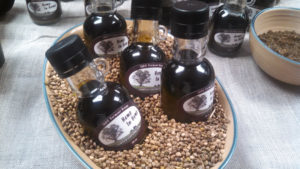
Hemp in Hemp is a delightful Farm-to-Table massage oil, muscle topical, and skin and hair conditioner. All from our Family Green small batch Vermont hemp harvest: this is top shelf, mineral rich hemp grown by family farmers. I like to throw a spoonful in the bath, and applied topically? May cause enjoyment in Sweetheart’s shoulders.
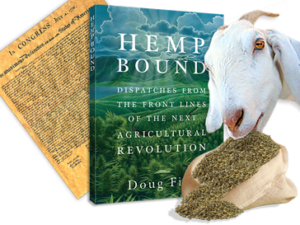
Book a live event here. Next up: the incomparable NoCo Hemp Expo March 31 and April 1 in Loveland, Colorado
Subscribe to the Dispatches From the Funky Butte Ranch newsletter and follow the daily Tweets @organiccowboy
“Doug has written the best book of the year and a blueprint for the future of America.” –Willie Nelson
The post Hemp Ninja Training appeared first on Doug Fine.
June 2, 2016
Hemptsy Is Open For Business

Incredible Oregon hemp body wash from Hemptsy Featured Artisan NGM
It was when I saw the first hemp lingerie on the site that I knew, finally, that this Hemptsy dream had become reality.
In the lead-up to the launch of this natural fiber artisan craft site, I envisioned craftspeople and farmers uploading their raw hemp hurd for animal bedding. Maybe some wool/hemp blended handmade shirts. Probably several batches of nutritious hemp hearts.
All very cool. And those things are there. But I accidentally created a regenerative Victoria’s Secret? I could think of a worse epitaph.
So here is the launch announcement promised in the previous Dispatch From the Funky Butte Ranch. It comes three weeks after the last one instead of one mostly because I’ve been planting hemp in Vermont — that’s me somewhat precariously manning the seed drill behind the biofuel-powered tractor in the photo you’ll see at the end of this Dispatch. If I look happy, it’s because I’M PLANTING HEMP.
Our Vermont project is a family farm co-op, incidentally. Our seed press, the gooey omega-rich outflow of which will be appearing on Hemptsy moments after harvest, is a 100-yard walk from one of our fields.
If you didn’t see the previous Hemptsy announcement, the elevator pitch is this: in the Digital Age, we wanted to create a marketplace (and thus a living) for Artisans who create with hemp and other natural materials.
It’s worked – we have wares on the site from South Africa to Oregon, Australia to Slovenia to the Beltway. And we only launched an hour ago.
Hemptsy, as of today, is open for business. Thanks for shopping here for all your gift, clothing, footwear, jewelry, raw fiber, cosmetic, literature, romantic and even livestock needs. The categories will keep growing as artisans continue to upload their magnificent work.
To you folks reading this, supreme thanks spreading the word about it, and helping it grow. Artisans will continually be adding their wares, we’ll have a gift card option up soon, and, well, now I’m ready for the men’s hemp underwear….
In the end, I’m still kind of blown away by the fact that humanity’s Digital Age survival, and the future industrial pipeline, from super-capacitors to nanotechnology, begins with a seed.
That’s fantastic, of course. What Hemptsy does is makes sure that craftsfolk have a shop for their one-of-a-kind and small batch artistry.
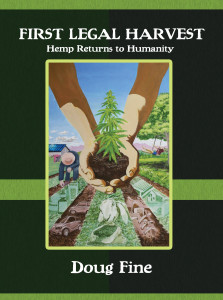
Above: The cover of the hemp-printed First Legal Harvest, the follow up to Hemp Bound (below), a book that Willie Nelson calls, “The best book of the year…A blueprint for the America of the future.”
Join us at (and book) Literally Hemp Bound events around the world.
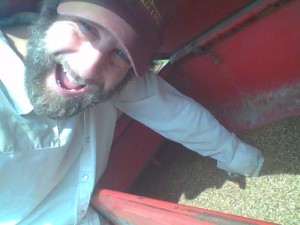
Humanity’s Digital Age Recovery Begins With A Seed. Subscribe to the Dispatches From the Funky Butte Ranch newsletter and follow my daily Tweets @organiccowboy
The post Hemptsy Is Open For Business appeared first on Doug Fine.
May 14, 2016
Calling All Artisans
Here’s the deal: Hemp commerce is exploding. Cultivated acreage is increasing tenfold in the U.S. for the third straight year, and the worldwide hemp boom is on. This is, of course, wonderful, a sooner-than-expected realization of the blueprint put forth in Hemp Bound.
But there’s a Be Careful What You Wish For side to this miraculous development for humanity. Let’s put it this way: I finally noticed that more than a few folks, from Slovenia to Alaska, were asking me some version of the same question: “Is there a space for the independent craftsperson when this dang industry is taking off faster than even the optimists (like you) thought possible?”
The repetition of this question in fragrant Asian markets and less-fragrant United National media rooms spurred me to action. It is fantastic that ventures, some fairly massive by any standards, are poised to transform, for instance, our plastics into petroleum-free bio-based products. And I’d love it if hundreds of thousands of U.S. acres were cultivated as domestic biomass energy feedstock.
But independent entrepreneurs of regenerative products should be supported, is my view. I’m overruling my normal distaste for presuming to have seance access to the departed, but I have strong reason to believe that’s what dudes like Thomas Jefferson and Ben Franklin would have wanted. And oh does the planet’s soil need it (lots of farmers caretaking independent, regional economies with a long-term mindset, all while making a living).
So that’s why I’ve created Hemptsy.com. It’s an artisan-friendly marketplace for folks in all fields who create from hemp or other bio-materials.
After months of development, the purpose of this Dispatch is to excitedly invite such artisans to please start uploading your work now. You’ll have seven days to open your shop, make your artisan statement, describe your products and prepare your pricing, before we’ll open it up to shoppers.
In a week, I’ll send another Dispatch like this one, announcing that Hemptsy is open for business. The subject line will include the words, “Open For Business.” There, putative shoppers, don’t you feel like you’re in on something?
Of course, artisans can always continue to upload products after the launch. But that’s when the wider world can start enjoying the one-of-a-kind and small batch items by-then populating the site.
And thus the world’s sustainable gift-giving worries will be, I hope, over forever. Along with its hemp heart yogurt garnish craving. And with every order a hemp gift card is available.
Hemptsy, by the way, is very kind to artisans. As you’ll see in this article in Cannabis Now magazine: we charge our artisans only 3% upon sale.
Eventually there will also be a 15 cent charge to artisans for product uploads, a token fee that gets a product on the site for six months. But for the first month it’s free for artisans to upload their work. That’s by way of thanks for proving that a successful hemp industry means the success of the independent artisan as well as the massive operator (who, let us repeat because it’s true, is also a piece of the puzzle, if we’re talking about species survival).
I and Hemptsy’s co-founder Mike Lewis, a Kentucky hemp farmer, would love to see products from purveyors of distinct, handcrafted work in all fields made from all bio-materials.
The site will include everything from shampoo to fine art, salves to super-capacitors, baskets to clothing, chocolate-covered hemp seed to livestock bedding (did you know the Queen of England beds her horses on hemp hurd? She must know about the plant’s comfort and anti-microbial properties).
Here’s a sneak peak at the Artisan Statement from two of our initial Featured Artisans (a monthly feature on the site):
Slovenian hemp toothpaste maker Vinko Škraban: “We at Planet Konoplje hope you enjoy our Hemp-Clay toothpaste grown by independent farmers in Slovenia. It provides extraordinary cleaning and re-mineralizing power for teeth.”
Maryland-based handcrafted paper maker Elishewa Shalom: “I make artisan hemp paper. Each handmade item offers a story and connects consumers to the farmers and artists who grow and process hemp fibers into beautiful and functional goods.”
Meanwhile, in other news: Lots of cool Literally Hemp Bound events coming up all over the planet this spring and summer: Hawaii in June (for Hemp History Week, great work with your terrific hemp bill, Aloha State, that passed unanimously in both houses), Colorado in July, North Carolina in August. (If you can’t make it to Maui for the June 4-12 celebration, I have friends putting on amazing Hemp History Week events in Kentucky, DC, Virginia, Colorado, Oregon and elsewhere. Hemp History Week is a very cool and effective organization. “On-message” is the phrase that comes to mind.)
And coming right up May 28-29 is a really special one. I’ll be teaching a two-day, practical hemp course at Sterling College in beautiful Craftsbury, Vermont. That’s this month.
If you’ve wanted to know how to join the hemp revolution, this is an ideal practical introduction to the burgeoning industry that includes both classroom instruction (in hemp agronomy, processing, and applications) and in-the-college-garden tips from myself and my Vermont hemp farming partners.
Huge thanks to Sterling College (“Working Hands, Working Minds”) for making the statement that a major industry is returning to New England.
Sterling is one of only seven federally-accredited work colleges in the U.S. And the only one I know of with an active maple syrup farm.
Register for one or both days of this practical Sterling workshop – you’ll see on the registration page that accommodations are available, both students and general public are welcome, and the keynote the evening before the course starts is free. For students this is a for-credit course. No hemp/cannabis experience necessary. This is an all ages welcome, family-friendly event.
You will learn how to cultivate hemp.
Space is limited and the course/workshop is in a few weeks, so I suggest registering fairly post-haste.
As for the prospect of cannabis in academia (Oregon State has a great course too, and I predict two dozen within three years), I think the message I’m getting is, “stay focused on cannabis/hemp long enough and eventually you get asked to be a professor.” Which is to say, stay in school, kids (ideally homeschool), and away from alcohol.
See you there and around the world, and you’ll be hearing from me in a week to announce that Hemptsy is ready for shoppers. (Remember, the embedded secret phrase “Open For Business.” For now, hold tight, is my message to what I hope is a legion of motivated fans of the site!) As always, please feel free to share this Dispatch From the Funky Butte Ranch far and wide.
And to all the artisans who comprise this Hemptsy craft marketplace adventure, I hope it’s a wonderful success for you. You deserve to make a living in the Digital Age. I know I’ll be a customer. And I love that every product comes from the soil.
* * * * * * * * * *
A Few Other Notes for Hemptsy Artisan/Vendors Who Are About To Set Up Their Shop:
–I found it pretty easy to navigate when I uploaded my own books. And it doesn’t take long. But if any artisans have questions during upload please email admin@hemptsy.com. In fact I figure you good folks will be helping spot and iron out bugs over the next week.
–In addition to uploading your product(s), don’t forget to describe yourself and your shop in the “Store Description” section of Settings on the Vendor Dashboard. Even a sentence just to show that you are a real person, and an artisan at that, who worked hard at what you’re offering.
-And a very important note: Before you are able to navigate the site (and this is only for this week), you will have to register as a vendor (since the site is not yet open to buyers). In other words, If you go the special vendor Hemptsy link I’ve been including throughout this Dispatch and immediately try to go to the home page or other links, it’ll just take you to a “Coming Soon” page. But if you first sign up as a vendor/artisan, you’ll be able to go to your dashboard, and even hit “Home” to see what the home page looks like, to check out the Founders Corner, and to peruse other shops. Fun times! Can’t wait to see what y’all have created.

The cover of the hemp-printed First Legal Harvest, the follow up to Hemp Bound, a book that Willie Nelson calls, “The best book of the year…A blueprint for the America of the future.”
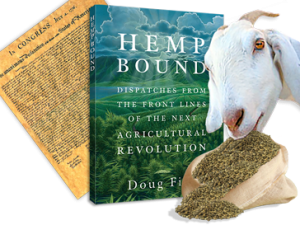
Subscribe to the Dispatches From the Funky Butte Ranch newsletter and follow Doug’s daily Tweets @organiccowboy.
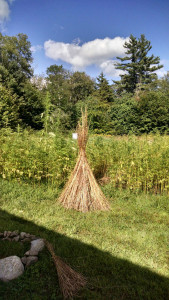
Vermont Hemp Field, Last Week
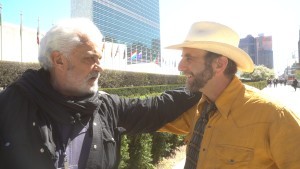
Above: Two farmers, one from Morocco, one from New Mexico, both dressed in hemp as they head into the United Nations to work on worldwide cannabis/hemp legalization. Below: Hemptsy Featured Artisan Elishewa Shalom at work.
The post Calling All Artisans appeared first on Doug Fine.
September 1, 2015
We Won. Now Every Decision Comes Down to Climate
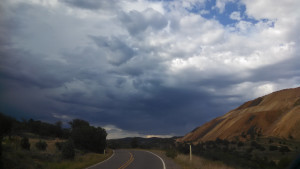
Monsoon Clouds Build Over New Mexico Copper Mine
This Dispatch comes in the form of the guest column I was asked to write for the European Coalition for Just and Effective Drug Policies (ENCOD)’s summer newsletter. This venerable and august group comprises the folks from twenty-three countries who brought me across the Pond last year to deliver a United Nations address we had collaboratively crafted.
Funny story: I found out I was delivering the address some minutes before it was to begin, after ENCOD’s founder Joep Oomen had his credentials stripped outside the Vienna session in a street theater misunderstanding.
In bestowing on me the assignment to update EU citizens about developments in U.S. cannabis policy, I see that the indefatigable Joep has also provided me a solid way to update folks in the States and elsewhere at this important phase of the total drug policy shift we’re seeing worldwide.
By Doug Fine
I’d like to start by recognizing that ENCOD is an organization devoted to legalizing all “drugs.” Because my research has been in the field of cannabis/hemp (often literally), I stick to it in this newsletter.
It’s another sign of victory in the long war to which this twenty-two-year-old organization is dedicated that we’re able to discuss recently inconceivable topics. I know some of you in ENCOD’s two dozen member nations have a few catch-up steps to take. But I live in your future so I know you will. Yep, I’m aware of that one Stone Age politician holding things up.
I’m pleased to report we’re at the stage of arguing about the mode of cannabis cultivation that is best for humanity as increasing percentages of us come to live under Drug Peace. In the U.S. more than half the population enjoys at least legal medicinal cannabis today, and radically new policy is evolving rapidly nearly everywhere: I’ve had strategy calls with folks in Missouri and Ohio this week.
Only for a short while longer will I be able to describe my reporting as coming “from the the front lines.” Since Joep requested an update on U.S. cannabis/hemp policy, I thought I’d start close to home.
This past year in my state of New Mexico, three connected events took place:
1) Our politically divided state legislature united to legalize hemp (already legal for research on the federal level). This hemp cultivation wording allowed our farmers, many trapped in a water-and-pesticide-heavy monoculture cycle, to join the first wave in hemp’s massive comeback. My state had gotten it together on a bill on which I had worked! God bless democracy.
One problem arose, though. We awoke one morning last April to find the bill vetoed by our Governor.
So now, embarrassingly, I live in a state at risk of lagging behind in the North American race to embrace hemp’s potential. That potential — including hemp’s drought-readiness and high market price — is why both major political parties and the state farmer’s union endorsed our hemp bill. It had almost no opposition.
After years of covering the game, I don’t usually get so worked up about politics, but this unconscionable veto affected my family, directly: with federal and state legalization dialed in, we would have cut thousands of carbon miles out of our human (and goat) diet this year. Hemp seed oil, most readers of this newsletter will know, is a nutritive superfood. It’s also expensive to import when your family eats about half the world supply. Oh well, we’ll try again next year.
By the time of the New Mexico veto, twenty-four U.S. states (now twenty-six) had legislated hemp cultivation, allowing their farmers and entrepreneurs to hop on the double-digit hemp economic growth train.

Vermont Hemp Field, Last Week
2) The people of New Mexico’s two biggest counties voted overwhelmingly to legalize all varieties of cannabis, in a non-binding election. Though we are a medical cannabis state, we don’t have statewide ballot initiatives in the Land of Enchantment, unlike the lucky residents of first wave legalization states such as Colorado and Oregon. So we have to endure, for a short while longer, a state administration that is on the wrong side of history. Our non-liberal neighbor Arizona, by contrast, is a shoo-in for full legalization in 2016. Why wouldn’t it be? Arizonans have an endocannabinoid system, too.
And 3) Our Monsoon rains came on-time last month. Some of you on the Atlantic Coast – in Galway, Bordeaux or Lisbon – might have heard the collective sigh of relief all of southern New Mexico heaved as moisture returned to our cells and hummingbirds to the datura blossoms. Monsoon season, the ecstatic and particularly blessed time of year here in the high desert (July and August), is when we’re supposed to get ninety percent of our precipitation.
It’s getting to be a rare occurrence for the Monsoon to start on time, or at all. Except for those years when it Biblically floods. In my line of work, sustainability journalism, the planetary situation is entwined with the return of cannabis. Which is to say, I’ve been researching whether and how widespread hemp cultivation can help mitigate climate change.
It had better. I don’t know if the atmospheric reality in Europe is as terrifyingly in-your-face as ours. Is that Gulf Stream still keeping you temperate while Greenland’s ice holds?
The change has already come to New Mexico. We’re getting used to millennial floods something like every other year, and a fire in 2013 caused a refugee bear to kill most of my family’s dairy providers and meditation partners: our goats.
The photo you see atop this newsletter shows the season’s daily Cumulonimbus formations building over the world’s largest open pit copper mine, which is half an hour from my solar-powered ranch. I like the clouds. Do we need the copper?
We need some of it, no doubt, for now. I’m sure there are yards (excuse me, metres) of copper in my putative Tesla. This is the one I’m trying to convince E. Musk to make: it comes standard with hemp paneling and solar-charged hemp fiber battery.
Since we’re in climate mitigation overtime, for me the most exciting part of my work describes the genuine, real world market performance that hemp and other natural fibers are incontrovertibly showing. Watch for (or, better yet, be part of) hemp apps ranging from energy storage to replacements for petrochemical plastics, epoxies and others among the most explicitly toxic components of our industrial output. You know, the stuff that’s brought us to the brink.
Not in my food, please. Many of you know that my goats bestow much of my protein. The yogurt I’ve been meaning to clean from my keyboard, for instance, originated fifty feet away, in the very animals at the moment yelling for their sunset milking outside my office window. Because of this reality, my lifestyle is part of my journalistic research. One literally feeds the other.
As such, let me remind us all: cannabis is a plant. Call me crazy, but I don’t welcome spray-on poison into my body with my broccoli, and I certainly don’t want to with any herb that’s in my diet. Furthermore, just as important as soil and water input, is energy input. There is this fantastic energy source, one that plants really like, called the sun. I’m a lobbyist for it.
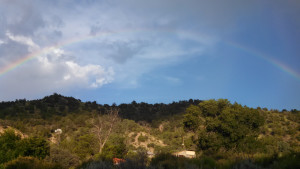
Monsoon rainbow over the Funky Butte Ranch. 2008’s Farewell, My Subaru tells the story of my journey to live without fossil fuels but pointedly with Netflix.
We who are engaging cannabis’ re-emergence represent the front end of a new economy, and, because the people, planet-wide, increasingly support us in that effort, we can craft, broadcast and implement the ethical rules for the Drug Peace Era. (Here is where I wanted to talk about coming changes in international drug policy, but I promised Joep that I’d keep the newsletter under two thousand words. So my two Euros on the coming United Nations Special Session addressing the three international narcotic drugs conventions — #UNGASS16 — will come another time.)
If you take only one kernel from this newsletter, I hope it’s this: I believe that every business decision (in any field), from power source at headquarters to the fuel powering the delivery vehicles, must consider environmental impact a core principle. The first question I’ll ask when you come with a business idea is, “What does your long-term climatic planning look like?” See, half my forest is burned. It looks like meadows of tar-covered toothpicks.
We all know that for cannabis to realize its humanity-helping potential, it must be cultivated sustainably. From there, insistence that the emerging cannabis industry should foster organic-style, small-batch locavore farming is a no-brainer.
The industry I support farms outdoors when possible (sun’s free), supplemented by light deprivation in real, local soil greenhousing when necessary. Low energy, full spectrum LED lighting technology — for supplementing natural light in wet or winter conditions — has been advancing by leaps and bounds. It’s not impossible in your climate: friends in Colorado wheel their entire garden outside for a few hours of divine solar wavelengths even in the depths of Rocky Mountain winter. As well, I’d love it if we’d all take some time to learn about the benefits of a robust native soil microbiology.
Long-term Drug Peace victory, I believe, requires an open mind and awareness that the cannabis world is evolving quickly. We can steer it any way we like. The really good news is I believe next generation business models that strive for a win-win among farmer/producer, Earth, customer, entrepreneur/investor/co-op member and everyone involved along the chain are actually going to prevail in the real world. And not just in the marketplace, but by providing healthier diets, clean energy, restored soil, and higher quality water. Maybe even a stabilized climate.
That is, if we can educate our own community about the importance of cannabis’ regenerative return. In preaching the sustainable cannabis message, I understand that prohibition necessitates hidden gardens. I hereby express my profound gratitude to the brave cultivators who provided this important herb at great risk during the dark days of prohibition.
Those days, thank heaven, are numbered. Which is why I propose that we prepare for the coming victory. What’s the source of my confidence? Polls. We now have fully legal cannabis in four U.S. States (and counting), plus the District of Columbia (DC), which supported cannabis with sixty-five percent of the vote (great work by Adam Eidenger and the Measure 71 team). We’re at fifty-eight percent of Americans supporting full cannabis legalization. That number increases with every national poll, even among older voters and self-described conservatives. They have endocannabinoid systems, too.
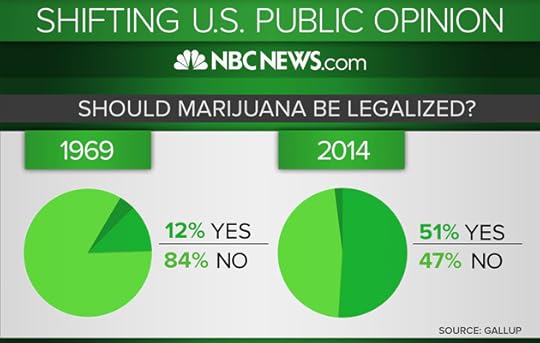
Last month, more than one hundred Republican and one hundred Democratic U.S. congressmen and women voted to prohibit federal interference in state hemp laws. It’s our most bipartisan issue. And it’s a major one, with the New York Times editorial board opining just last week that federal movement on legalization is not moving rapidly enough.
Even conservative states like Texas and Virginia could join the crowded field of states that legalize in 2016. The only question is “when will the Big Change come on the federal level?” If the U.S. Congress removes cannabis from our Controlled Substances Act (CSA) entirely when it reconvenes this month, much of the nation will shrug.
Few in the drug policy field believe our current President will veto any progressive plan. He might even issue a helpful executive order. But millions of us are watching potential successors for their cannabis views and priority levels, in case it’s not all solved, federally, by 2016. I think cannabis will be removed from the CSA within three years – by 2018, allowing states to regulate it as they wish, similar to beer.
Here I direct appreciation to voters in the states that legalized before it was common. Of these fantastically impactful citizen-driven state legalizations, the ones that allow home cultivation are the best: Oregon is a great model written by my friend Anthony Johnson and the terrific Measure 91 crew.
Thrillingly, each wave of legalizations allows better citizen initiatives (and state legislative efforts) to follow, as more and more Americans see the success (in tax coffers and public safety increases) of the early legalization efforts in the real world. Now we have momentum.
Beyond the actual legalization wording, here’s what I look for in an initiative or bill: to my mind, cannabis prohibition is over when anyone can cultivate in a home garden. Any talk of patenting an herb is absurd.
We also need to completely transform red-districting of cannabis into awareness that legal cannabis increases community safety, economy and quality of life. I just thought of a slogan: “Yes, please, in my backyard.” Or, to paraphrase a dispensary owner I covered in Too High to Fail, please remove the real dangers (the bar and pharmacy) in my neighborhood and replace them with a cannabis lounge.
On the commercial side, small batch cultivation must be codified, with tax breaks for sustainable cultivation. This “craft brew” sector, which in the cannabis world is comprised of folks Michael Pollan calls “the best farmers of my generation,” was worth eight billion dollars per year to independent beer brewers in 2010.
Put all that in an initiative, perhaps topping Oregon’s acceptably friendly half-pound possession and four-plant home garden limits, and then, I think, we have at least allowed ourselves to reap the benefits of the Drug Peace with a fair trade and organic mindset.
Mapping to European models, this ethic applies whether you call yourself a social club, an entrepreneurial venture, or a collective (or even a non-profit or an educational institution). I don’t care so much about categories as practices.
Already, the federal bureaucracy is no longer the problem in the States. I’ll give you a personal example: not only did a Kentucky project I was working with receive a federal permit to cultivate hemp this past spring (with invaluable support from the state Agriculture department). When the permit needed to be amended, the good folks at the U.S. Drug Enforcement Administration did so within seventy-two hours. It used to take seventy-seven years.
Even Katie Couric, perhaps our most mainstream newscaster, has been explaining to every American housewife why the return of ganja (her word choice) is to the good.

With or without official help, the hemp industry is growing twenty-four percent per year, and seeds are in the soil from sea to shining sea in the American heartland. California’s medicinal cannabis industry pays one hundred million dollars in sales taxes annually. Therein the cynical will find their favorite explanation for the war’s end. Fine with me.
It’s not all milk and honey. We’ve seen politics interfering in Oregon, an important but controversial legalization effort in Ohio, penny stock speculators playing their cards, and difficulty importing hemp seeds.
But I leave you with this, my European friends: if your über-celebrity newscaster can issue a truthful cannabis report to your nation’s most conservative viewers, you are in good shape. If not, let’s redouble our efforts, and let me know how I can help.
During 2013’s five-nation Too High to Fail European tour, even tour organizers (and true Drug Peace heroes) Michel Degens and Derrick Bergman had doubts about the “we’ve already won” certainty I brought across the Pond like some kind of exotic spice. Just two years later, I hope, we all know the end is in sight. Just in time.
As I heed the braying call to the goat milking (see below for the newest Funky Butte Ranch kids, Feist and Mork) a prayer is on my lips that the Monsoon rains will continue for another year.
Also on my mind is the question around which I hope we’ll frame at least some of this year’s discussion: how can we best set the opposition’s terms of surrender so history will remember us as kind, effective, and regenerative?
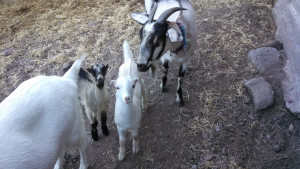
See y’all on the First Legal Harvest/Hemp Bound live event tour, currently vegetable oil-powered, soon to be hemp-powered. Book via the events page at: http://dougfine.com/events/

The cover of the hemp-printed First Legal Harvest, the follow up to Hemp Bound, a book that Willie Nelson calls, “The best book of the year…A blueprint for the America of the future.”
Subscribe to the Dispatches From the Funky Butte Ranch newsletter and follow Doug’s daily Tweets @organiccowboy.
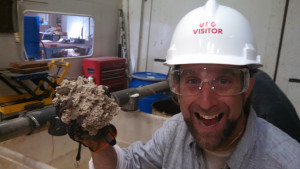
Stay tuned for news of a cool hemp-related project on which I’ve been working for six months. Hint: in this photo I’m touring one of the first domestic hemp processing facilities of the modern era. This, by the way, is how a writer looks when he finally has an answer to how post-tree publishing looks (AKA when he is squishing hemp paper pulp). Thanks to Ed Lehrburger and Morris Beegle for coordinating the visit, and I’ll be able to spill the beans on this massive project soon.
The post We Won. Now Every Decision Comes Down to Climate appeared first on Doug Fine.
February 15, 2015
First Legal Harvest: Game on For the Hemp Industry
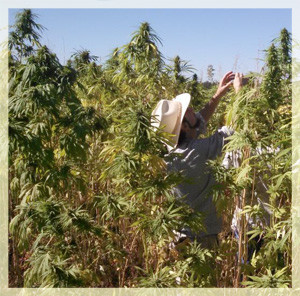 FIRST LEGAL HARVEST:
FIRST LEGAL HARVEST:Game on For the Hemp Industry
Pre-order the new, must-read hemp-printed 2015 report from the world’s industrial cannabis fields and the digital age industries they are already supplying. By the acclaimed author of Hemp Bound.
While touring the world in 2014 to speak about his bestseller Hemp Bound , Doug Fine traveled to half a dozen hemp farms, processors and research facilities from Slovenia to Kentucky, Canada to Oregon, to bring us this 20-page report, partly printed on the first legal American hemp harvest in 77 year itself. Did you know American hemp is on its way to your car battery? Did you know that today, Canadian and Belgian farmers are making five times the per-acre revenue that they were from corn, wheat and soy? It’s all covered in acclaimed author Fine’s typically humorous and rigorous from-the-field investigative journalism.
First Legal Harvest: Five hemp farms. Six weeks. One revived industry. The Dreaming’s Over: Now it’s Time to Get to Work
Domestic USA Pre-Orders

International Pre-Orders
 And if you haven’t read Hemp Bound?
And if you haven’t read Hemp Bound?It’s a great companion read, Doug’s book length description of everything hemp, from the traditional uses of the plant through the countries and people leading the industry back across the billion-dollar mark.
Follow Doug on Twitter: @Organiccowboy
The post First Legal Harvest: Game on For the Hemp Industry appeared first on Doug Fine.
October 16, 2014
Seven Hemp Farms. Two Continents. One Revived Industry
First Legal Hemp Harvest Update
American Hemp Is On Its Way to Your Car Battery And Your Bookstore
The first digital age domestic hemp crop is being harvested as I write. The subtle decrease in seismic activity currently puzzling Virginia geologists can be traced to Thomas Jefferson ceasing to spin in his grave for the first time in 77 years.
So begins the latest write-up resulting from the recent #HempHarvestTour2014. A note on that preceding “word,” or whatever it is, since its style was absent from my English grammar book. Based on the reality that half my friends think me pre-scholastic in my new media literacy and half see me as more of a trend-hopping Cosmonaut, I figure we are in a place where about half of the folks reading this Dispatch will know what the heck the hashtag business is all about.
Think of it as a supplement. You won’t be out of the loop if you aren’t on Twitter as long as you read Hemp Bound, that worldwide hemp industry investigation and re-launch blueprint that, fortuitously, was published during this, the crop’s biggest year in the last twelve thousand.
But for those who do Tweet, #HempHarvestTour2014 amounts to a 200-image photo documentary of these historic harvests between which I’ve been bouncing, from Slovenia to the first legal American hemp harvests of the Digital Age, in Kentucky and Colorado.
Compiled together in an essay, these reminiscences (sorry, these in-the-field-researched pieces of investigative journalism – ya never know when the Pulitzer committee might be reading) will comprise the hemp-printed First Legal Hemp Harvest Dispatch that (stay tuned) you’ll be able to order in the new year. An excerpt just ran here.
I’m working with my pard Morris Beegle of Colorado Hemp Company on that first hemp-printed project, and so far American hemp farmers in three states have volunteered to contribute fiber. We hope this will spark a publishing revolution grounded in tree-free, renewable American hemp. As a father, I haven’t been this optimistic about my replicants’ future since before last year’s second “Millennial” flood this decade wiped out the Funky Butte Ranch driveway again.
If reading Hemp Bound, clicking around the blithe #HempHarvestTour2014 Tweets and waiting for the First Legal Harvest printing announcement aren’t enough immersion in what is for Canada already a billion-dollar hemp economy, you still have three more ways to procrastinate from whatever your real job is (glad to be of service: it’s educational, at least). You can check out or book the Hemp Bound live event here.
In a “Have Scythe: Will Harvest” moment, here‘s a chance to watch me being schooled — with a dangerously medieval tool — in hand-harvesting hemp by Slovenian farmers.
And since I’m speaking so much about sustainability in the emerging hemp and cannabis industries, if you haven’t seen this TEDx Talk, “Why We Need Goatherding in the Digital Age,” it explains a lot of where I’m coming from in my work.
Back on the Twitter thing, my daily Tweets range from dewey datura photos to video clips from recent United Nations testimony. That’s @organiccowboy.
And for the 50% of folks who process information in what you might call a more seasonal fashion, that hemp-printed First Harvest Update is coming your way at the beginning of February—just when you’re thinking, “Hmm, I’ve read Hemp Bound. I wonder if there’s an update.”
There’ll be a pre-order with deposit for the historic first run, announced in these Dispatches and via Twitter. Here’s what we’re thinking for a pitch line: “American hemp-grown literature: makes a swell Valentine’s Day gift.”
But ya really want to read Hemp Bound first so you’re grounded in the remarkable economic foundation hemp provides as you read about the first folks to prove said foundation’s reality on the ground this season. One of the harvests I visited is being used for next generation batteries by a nanotechnology company.
And in closing, whether a hemp-based publishing industry sounds farfetched or a sensible necessity to you, check out this scene from the Hemp Bound event that C-Span’s BookTV aired this summer: shortly after I’m introduced by two of my Colorado hemp heroes, Lynda Parker and Michael Bowman, I display, discuss and leaf-through the mint condition 1731 hemp-printed book (about the Dutch Reformation) that an audience member had brought to the event. I found it significant that the book’s owner had no problem with, for instance, a fellow leafing through a priceless heirloom, or skin oils damaging the fiber.
Well, off to milk the goats. They have very few problems, too. Some more harvest-time photos are below. My thanks to everyone reading this is for, especially, allowing me to pursue a working life that gives me so much pleasure.
-Doug Fine Funky Butte Ranch, NM
Dreaming’s Over: There’s Real Work to Be Done. Doug Fine, Solar-powered Goat Herder (I-Land of Enchantment) Harvesting Hemp With Katie Moyer (I-Christian County, Kentucky), American Mother and Hemp Farmer. The yellow crop beyond the standing hemp field in the far background is tobacco. Moyer gave me and my Kentucky tour host Josh Hendrix a container of her hemp muscle salve from some just-harvested plants. Within five minutes of application, after a day of driving Kentucky hills and stripping retted hemp bark from fiber, I knew that when this stuff is on Walgreens shelves, the ibuprofen folks (Bless ‘em for decades of hard, if chemical work) are in trouble.
Flashing the American sign language sign for hemp at World Hemp Congress, Lendava, Slovenia. That’s a hempcrete pyramid in the local park in the background. The hemp sign, invented by David Piller and taught to me in person at an April Hemp Bound event in Colorado, becomes official in American sign language when it’s in common use. So please flash it often, folks (as I did on Colorado public television recently) — it’s cool. One of the fellows in the photo, Vinko Skraban, owns Planet Konoplje (Hemp), a company that now provides my family’s toothpaste.
The post Seven Hemp Farms. Two Continents. One Revived Industry appeared first on Doug Fine.
July 21, 2014
HEMP BOUND Live
Admittedly the competition is weak with only “Erik Estrada Sings the Standards” and “Yo Gabba Gabba On Ice” sharing the road this fall, but you really do want to check out the Hemp Bound live event tour. You don’t even need a babysitter: it’s family friendly except for a couple of photos of Harry Anslinger.
The rollicking and rigorous, funny and timely Hemp Bound show (like the book, only with slides and 17% more jokes) discusses a model for tri-cropping hemp. That means three uses for one harvest: seed oil (very profitable to Canadian farmers as we speak), fiber (hemp fiber is in Mercedes door panels today) and energy (through biomass gasification).
Here’s a sample as aired on CSPAN following a recent event in Denver. I’ve looked into it, and it’s pretty rare for a domestic hemp crop blessing to be broadcast on national TV. Same with a display of an 18th century hemp-bound book in mint condition. And for anyone not named Harrelson to be dressed head to toe in hemp.
http://www.c-span.org/video/?318921-1/book-discussion-hemp-bound
Hemp is returning so briskly that even I have trouble keeping up. Each day brings new developments, in policy and in the fields. At every Hemp Bound event so far, someone has approached me to discuss birthing some leg of that tri-cropping model that (I still can’t believe this) Willie Nelson calls “a blueprint for the America of the future.”
At the Colorado Hemp Expo in April, a fellow collared me at the refreshment stand and said, “I came here from New York to figure out where to invest in hemp and now I realize I want to wholesale those gasification units to farmers.”
Game on. This is not a dream. It is really happening. I have a dozen more stores like that, and the book is just out.
The tour is bouncing from South Carolina to Slovenia, but it starts in Hawaii. That one is called the inaugural Maui Hemp is Hope Conference and Workshop, and it’s close to my heart.
https://www.indiegogo.com/projects/hemp-is-hope-workshop-on-maui
The whole first class shebang is a labor of love by the the nonprofit Sustainable Biodiesel Alliance. Those good folks, with help from the Maui Farmers Union and the University of Hawaii Maui, are crowd funding this week to defray costs as they bring in hemp experts from around the world to the place that might need hemp the most: for soil remediation, local food and energy. Hawaii is on it — one of 15 current hemp cultivation states.
Then the tour moves to the 21st Seattle HempFest, before touching down in once and future hemp industry powerhouse Pennsylvania (Twice: I’ll beat the Mother Earth News Fair and at Franklin and Marshall College).
Then in to DC (keynoting the Hemp Industry Association Conference), Portland, California, and back to Colorado in October — in time for the first state-sanctioned commercial hemp harvest in the United States this century.
I’m excited about these upcoming two dozen tour stops, because they mean hemp is returning to the soil planet-wide. Once you read Hemp Bound, you realize that this is pretty much crucial for humanity’s survival. I’m particularly psyched to bid goodbye to petroleum-based plastics and chemical-soaked construction materials. Hemp’s out-performance of these is well documented in the book.
All of the fall and winter events are here at:
http://dougfine.com/events/upcoming/
And there you can also make contact if you’d like to book an open date.
See y’all there, if I can get the Monsoon-erased Funky Butte Ranch back diamond driveway re-engineered. The annual and expensive desert havoc is worth it, for the moisture in the cells and the hummingbirds in the datura blossoms alone.
-Doug
Funky Butte Ranch, NM
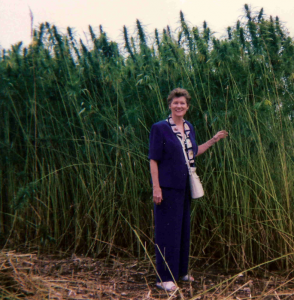 Hawaii State Senator Cynthia Thielen (R-Oahu) Tours a Belgian Hemp Farm
Hawaii State Senator Cynthia Thielen (R-Oahu) Tours a Belgian Hemp Farm
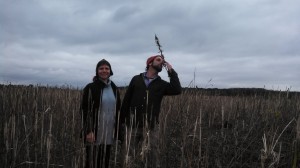 Doug Fine, Solar-powered Goat Herder (I-Land of Enchantment), Tours a Belgian Hemp Farm. (Farmer: Ingrid Maris)
Doug Fine, Solar-powered Goat Herder (I-Land of Enchantment), Tours a Belgian Hemp Farm. (Farmer: Ingrid Maris)

The post HEMP BOUND Live appeared first on Doug Fine.
Doug Fine's Blog
- Doug Fine's profile
- 14 followers


